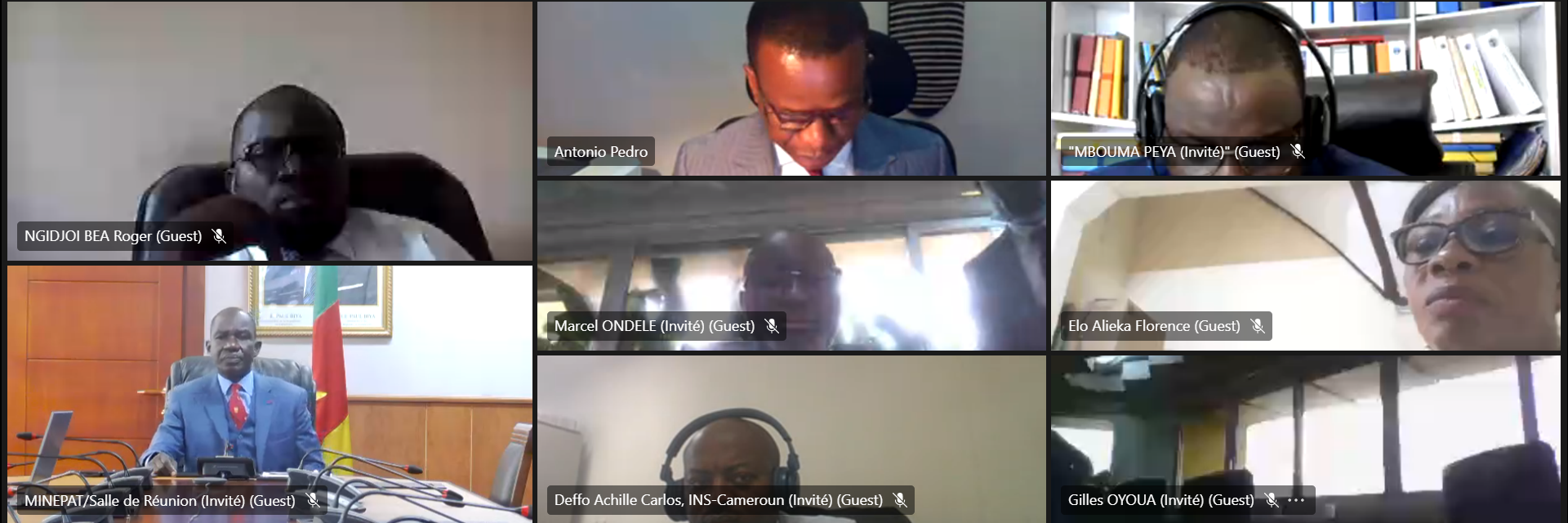Yaounde, 5 May 2021 (ECA) – Imagine development planners in Central Africa getting their hands on a smart and integrated tool which helps them identify the most profitable points to deploy investments for the expansion and deepening of value chains in agribusiness, manufacturing, mineral transformation and beneficiation as well as an endless flow of renewable energy to leverage their current development plans!
The United Nations Economic Commission for Africa (ECA) has just presented results of its findings using such a geospatial and investment planning tool to member States, the economic communities of the sub-region, and other development partners and experts during an online workshop presided by Cameroon’s Minister of Economy, Planning and Regional Development, Alamine Ousmane Mey, this Wednesday.
ECA’s preliminary geospatial-data driven analysis on economic opportunities along Central Africa’s transport corridors showcases the far-northern regions of Cameroon, connected to the whole of Chad as one of Africa’s best spots for the development of a value chain in wind and solar renewable energy.
The area boasts an average of 22, 000 kilo joules per metre square of sunlight per day and a wind power density of more than 42 joules per cubic metre.
The analysis therefore calls for the development of this unrivalled potential and link it to the deployment of locally-produced ion-lithium storage batteries, coming to existence by leveraging the weight of the Democratic Republic of the Congo’s as a producer of over 60% of the cobalt used for electric cars at the moment and host to the world-class Manono lithium-tin deposit which is estimated to be one of the largest lithium-rich LCT (lithium, caesium, tantalum) pegmatite deposits in the world. The reflection is wink to the subregion to make hay while its sun shines in these domains, with a view to capturing far more than its 3% stake in the battery and electric cars sector which will be worth 8.8 trillion dollars by 2025.
Another important sector in which Central African countries should develop a value chain is agribusiness in which rice, maize and meat development are identified as some of the most profitable sub-sectors. Here, the Douala- Bangui and Douala-N’Djamena corridors are underlined as examples.
A case study on how to make the Kribi-Edea-Douala continuum in Cameroon, as a zone with the propensity of kick-starting a hub in the development of pharmaceuticals, was put forth. It would be called the Kribi-Edea-Douala (KED) Growth Triangle.
Minister Alamine Ousmane Mey said ECA’s preliminary report is “about turning these many assets into real economic opportunities in order to create a more inclusive area of prosperity and development”.
“It also about boosting economic diversification and strengthening the resilience of our economies while increase industrial activity”, he added.
The Vice President of the Development Bank of Central Africa (BDEAC) – Marcel Ondele said ECA’s analysis will help his organisation to revise the Central Africa Consensual Transport Master Plan (known as PDCT-AC in French), notably on the Brazzaville-Douala-N’Djamena corridor, the Libreville-Brazzaville corridor, the Douala-Kribi-Bata corridor and the Bata-Libreville corridor.
“Today, Africa has become a continental free trade area. Therefore, the corridors are real vectors of economic integration and poles of development”, he said.
“Reconfigured corridors should allow us to connect the capitals of Central Africa and thus boost trade in the Zone for economic and social development,” he added.
The Director of Central Africa’s Subregional Office of the United Nations Economic Commission for Africa, Antonio Pedro, pointed out that “our ambition goes beyond the analysis of corridors because the emergence of information technology now makes it possible to process large amounts of data with great precision and at low cost”.
“With the development of artificial intelligence methods, we can process spatial data with higher degrees of sophistication to support the discovery of areas with the greatest growth potential, direct investments and improve the quality of economic planning, at whatever scale we need” he argued.
“Because access to spatial data is getting cheaper, the sources of data are expanding including Big Data coming from the private sector and simple information collected by individuals using mobile phones, and processing of voluminous data is getting easier than ever, there is an opportunity for Central Africa to modernise its data infrastructure and systems, and bypass the current weakness of national statistical systems which struggle to keep up with the data requirements of the SDGs and other national and international agendas, to take development planning, investment targeting, and regional development to another level of sophistication, disaggregation, and context specific assessments ” he added. This can support VLRs, decentralisation, meso and macro planning, he concluded.
He noted that making use of natural capital accounting, to enable the subregion to audit its vast resources and present them as strong elements for rebasing national wealth, would help broaden the fiscal space to make these investments.
Various experts from governmental and regional bodies as well as others from development organisations and the world of research mooted for the consideration of the forest/wood, iron ore development and tourist sectors as areas in which to extend the analysis on the development of value chains in Central Africa.
Arguments were also advanced for a more granular review of the place of cities as development poles for economies of agglomeration linked to transport corridors.
Mr Pedro promised that these considerations and the feedback received during the launch of the study will feed the second stage of the deployment of the GIS-enabled assessment tool in Central Africa. The latter will require close collaboration with relevant government authorities in the sub-region, CEMAC and ECCAS, and development partners such as the World Bank, the EU, and the AfDB.
#-ENDS-
Media Contact
Abel Akara Ticha - Communication Officer
United Nations Economic Commission for Africa
637, rue 3.069, Quartier du Lac, Yaounde, Cameroon
Tel: +237 222504348
E-mail: akara@un.org

